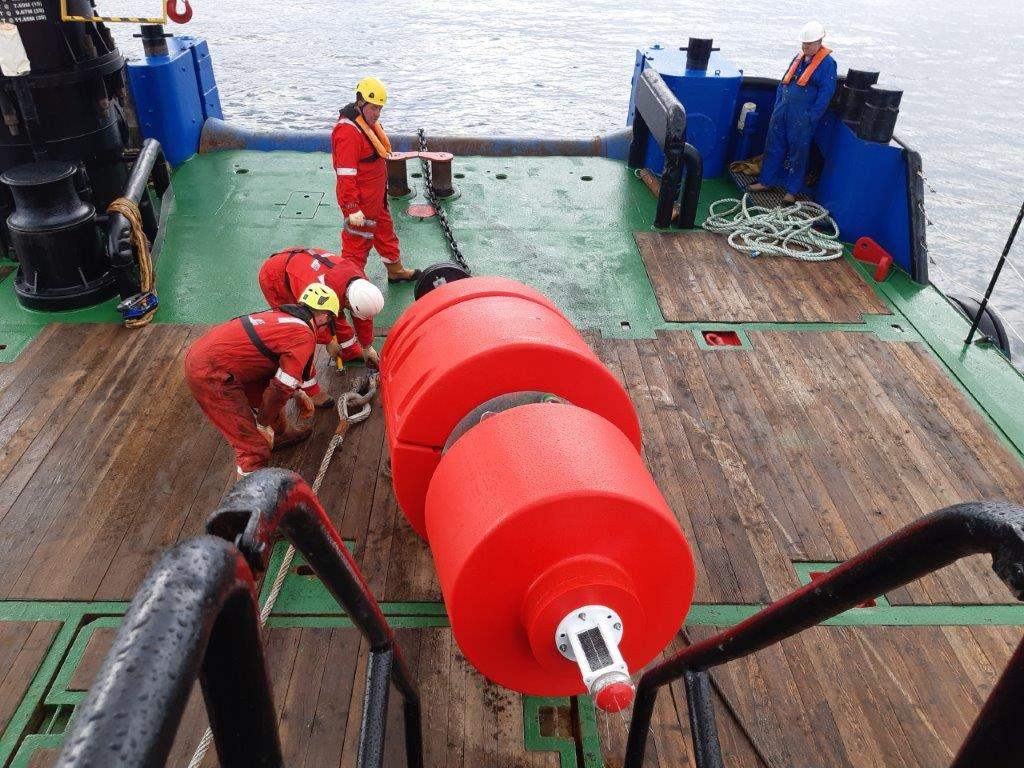The northeast corner of Scotland has historically had a problem with severe weather breaking away a north cardinal mark in Wick Bay. We recently undertook a buoy and light installation project in the area with Wick Harbour Authority.
With the installation of a new offshore wind farm nearby, the customer had been looking more closely at the navigational aids they provide for users. Although the wind farm is more or less built now, operations and maintenance work over the next few years will continue to see many small vessels going in and out of the harbour.
The locals may know where the hazards are, but new visitors may not. As such, the main aim of the project was the improve safety and make the harbour area and hazards more understandable for visiting boats.
Overcoming challenging conditions
Outside the harbour, there were the remnants of an old breakwater, which posed a significant hazard to vessels. Over the years, we’d spoken to the harbourmaster about putting some form of spar-type buoy in place for summer use only, as he never thought it would be able to survive the winter in such a rough environment.
The area around Wick Harbour is quite an exposed place, so when the weather is bad from a particular direction – mainly the east – we often see big rolling swells. Without an appropriate mooring, big waves can pick up the buoy and throw it. As the wave moves through, the buoy lifts the chain which creates the drag to pull the buoy over the top of the wave and then back into position. However, if the buoy is still going forward when it runs out of chain, it will merely stop dead: this is when things start breaking.
However, with the right mooring, a buoy can ride out these challenging conditions…
Deep buoyancy
After a simulation using the IALA-approved Calmar Mooring Line Calculation Software, it became apparent the site did not suit buoyage in that position. Developed by Mobilis, the Calmar software allows you to know how much chain to use in different scenarios, so you are confident that even in the worst conditions, the buoy will still be there in the morning.
After a little bit of convincing, we decided to deploy a port hand mark, the Mobilis AQ-1500, further out into deeper water. Although it is only 1.2m in diameter, the buoy has a deep buoyancy of about one and a half tonnes — meaning it rides out severe conditions well and is fully capable of surviving the worst Scotland can throw at it. Along with the 55m chain and 2T sinker, the buoy featured a self-contained solar-powered light, as well as a 1m wide polyethylene daymark and radar reflector.
Impressive viewing distances
Following discussions, the customer also mentioned they were considering modernising the harbour’s port closure signals. We felt the best solution was to install three VEGA VLL-43directional lights, which are mounted horizontally. The divergence is about 30 degrees, and the intensity is excellent — enabling a decent output from a small amount of power.
These lights are controlled by Hydrowatch, a remote monitoring and control system that has been developed in house by Hydrosphere. The system allows the customer to turn the traffic lights on and off, as well as monitor the mains power supply, the battery voltage and any other inputs or outputs remotely. Meaning staff no longer have to access a potentially dangerous area to display the port closure signals.
Initially, we quoted the lights as giving a nominal daylight viewing distance of about 0.7 miles; but in practice, the customer is seeing good results up to around 2 miles even on a bright day and receiving night-time distances in the region of 10 miles.
A happy customer
The buoy and lights have been in place for just over a month now, meaning that for the first time, vessels have a reliable lit reference all year round as they approach the bay from both the north and south, before picking up the leading lights of Wick Harbour.
Deputy Harbourmaster Ian Cormack says: “Feedback from our stakeholders has been very positive on both these projects and we look forward to continued business with Hydrosphere”.
To discuss working together or to find out more about our other projects, please contact us today!








